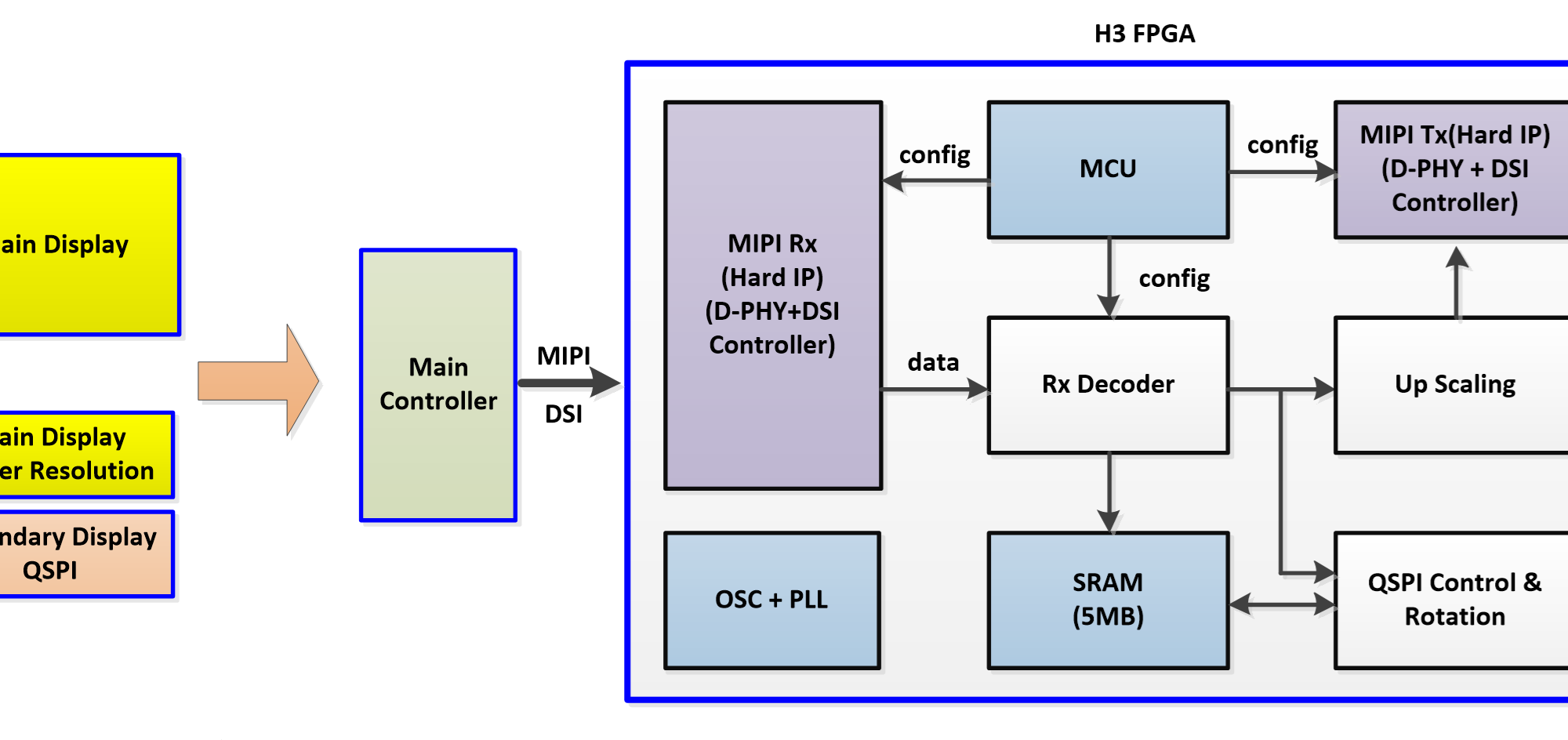Flexible LCD technology has spurred a wave of creativity in device design, including a new class of foldable phones and an update to the venerable flip phone. Besides the primary display inside the fold – sometimes taking the entire inside area – a smaller secondary display is often found outside the fold. Introducing the secondary display adds more challenges than meet the eye. One of Mixel’s MIPI IP customers, Hercules Microelectronics, is creating innovative MIPI solutions for driving dual-display foldable devices.
Offloading foldable display tasks from an application processor
Adding a feature to a mobile device often means adding an IP block to the application processor (AP). Driving dual displays reveals subtle integration issues, including always-on requirements, that make a strong case for a different implementation.
The first is the physical interfaces. MIPI interfaces are standard in mobile devices, offering speed and power efficiency for driving displays. MIPI is the unquestioned choice to drive the primary foldable display. Still, power requirements increase if the AP manages the MIPI interface as primary displays move to higher resolutions and increased frame rates. Conventional solutions to save power are well-known: dimming the display, reducing its resolution or frame rate, or powering it down entirely.
Add a secondary display on the outside of the device case, usually smaller and with a lower resolution. Reducing the size and costs of these displays has pushed vendors to an alternative interface – QSPI, a feature often found on pin-count-sensitive microcontrollers but not on most APs. Physically adding QSPI is simple, but keeping portions of the AP on just to drive a small always-on display gets expensive in battery drain. The secondary display power requirements increase with rotation, chewing up computational resources and power to keep the display upright as the device turns.
All this points to what might be a counterintuitive conclusion for mobile device designers: an external dual display controller could achieve overall power savings by offloading foldable display tasks and keeping the AP at minimal power when folded. Using an external controller also reduces the time and risk of modifying an AP for dual-display foldable devices and their always-on nature.
MIPI interfaces integrated into low-power FPGA manages dual displays
This external controller would have to be low power yet have enough performance to take a MIPI stream from the AP host and convert it into a MIPI interface for the primary display with resolution up-scaling and a QSPI interface with the required rotational processing and always-on control. Ideally, it would also quickly adapt to various display configurations to keep costs down while supporting various foldable devices.
Hercules Microelectronics (HME) has a family of low-power SRAM-based FPGA devices that fit this profile. Their HME-H3 combines an Arm Cortex-M3 core and six hard MIPI IP products included: a C-PHY/D-PHY combo Rx with DSI peripheral and CSI-2 Rx controllers and a D-PHY Tx with DSI host and CSI-2 Tx controller cores. Adding the QSPI interface and control to the FPGA logic in the H3 is straightforward for a complete dual-display solution, as shown next.

Mixel provided HME with its MIPI C-PHY/D-PHY Combo IP and MIPI D-PHY IP. Mixel’s MIPI IP supports MIPI C-PHY v2.0 with 3 trios at speeds of up to 2.5G symbols per second per trio and MIPI D-PHY v2.5 with 4 lanes at speeds of up to 2.5Gbps per lane. These lanes provide a total aggregate bandwidth of 17.1Gbps in C-PHY mode and 10.0Gbps in D-PHY mode. HME achieved first-time silicon success with Mixel’s integrated MIPI solutions.
With Mixel’s MIPI IP products deployed in many applications, this was a low-risk, rapid-return solution for HME and its customers. The HME-H3 was already in use in video bridging and embedded vision applications and extending it to dual-display foldable device applications opens more possibilities for designers.
HME-H3 is Hercules Microelectronics’ second-generation product to leverage Mixel’s MIPI IP with first-time silicon success. The first product, HME-H1D03 FPGA, integrated Mixel’s MIPI D-PHY IP and won Best FPGA of the Year Award at the 2020 China IC Design Achievement Award Ceremony.
Flexible LCDs free designers from many physical design constraints, leading to a wide range of foldable and flip devices entering the market. The success of any mobile device in the market continues to rely on a blend of display performance and power efficiency for the experience users expect. MIPI solutions for driving dual-display foldable devices are crucial to achieving the experience.
See what Hercules Microelectronics and Mixel say about this application:
Mixel MIPI C-PHY/D-PHY Combo IP Integrated into Hercules Microelectronics HME-H3 FPGA
To learn more about Mixel’s MIPI IP product solutions in this application, please visit:
Also Read:
Ultra-low-power MIPI use case for streaming sensors
2024 Outlook with Justin Endo of Mixel
Automotive-grade MIPI PHY IP drives multi-sensor solutions
Share this post via:






Comments
There are no comments yet.
You must register or log in to view/post comments.